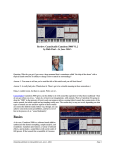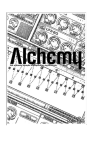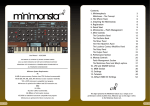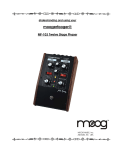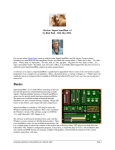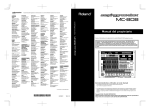Download VENGEANCE Crusher 2005 User manual
Transcript
Camel Audio
CamelCrusher
Version 1.0
User manual
1
Table of Contents
User License Agreement.................................................................................................... 3
Welcome.............................................................................................................................4
Highlights........................................................................................................................ 4
System requirements.......................................................................................................... 5
If you like CamelCrusher.....................................................................................................5
Installation...........................................................................................................................6
Notes: Windows.............................................................................................................. 6
Notes: Mac OS X............................................................................................................ 6
Start here!........................................................................................................................... 7
Try the Presets................................................................................................................7
Think modular................................................................................................................. 7
Randomize!.....................................................................................................................7
Save Presets...................................................................................................................7
Try MIDI Learn................................................................................................................ 8
Come back soon............................................................................................................. 8
User interface features........................................................................................................9
CamelCrusher logo................................................................................................................... 9
Main display.............................................................................................................................. 9
Knobs...................................................................................................................................... 10
Effect modules.................................................................................................................. 11
On/off switches............................................................................................................. 11
Distortion................................................................................................................................. 11
Filter........................................................................................................................................ 11
Compressor............................................................................................................................. 11
Other Modules.................................................................................................................. 12
Master..................................................................................................................................... 12
Frequently Asked Questions.............................................................................................13
Credits...............................................................................................................................14
2
User License Agreement
This User License Agreement is a legal agreement between you and Camel Audio for the
product accompanying this document, which includes software and all associated media
('SOFTWARE'). By installing, copying or using the SOFTWARE, you agree to be bound
by the terms of this license. If you do not agree with the terms of this license, you may not
use the SOFTWARE.
The SOFTWARE is protected by copyright laws and international copyright treaties. The
SOFTWARE is licensed, not sold. You may not transfer, modify, rent, lease resell,
distribute, network or transmit the SOFTWARE. You may not reverse engineer,
decompile or disassemble the SOFTWARE. You are not permitted to copy the
SOFTWARE.
All title and copyrights in and to the SOFTWARE and any copies of the SOFTWARE are
owned by Camel Audio. The SOFTWARE is protected by copyright laws and international
treaty provisions. Unauthorised reproduction or distribution of the SOFTWARE or
documentation is subject to civil and criminal penalties.
The SOFTWARE is provided 'as is' and without warranty of any kind. The entire risk
arising out of the use of the SOFTWARE remains with the user. Camel Audio disclaims
all warranties, either express or implied, including, but not limited to, implied warranties of
merchantability and fitness for a particular purpose, with regard to the SOFTWARE. In no
event shall Camel Audio be liable for any consequential or other damages whatsoever
arising out of the use of or inability to use the SOFTWARE.
'Camel Audio' and 'CamelCrusher' are trademarks of Camel Audio. 'VST' is a trademark
of Steinberg Soft – und Hardware GmbH. All other trademarks are the property of their
respective owners.
© 2005 Camel Audio. All rights reserved.
3
Welcome
Welcome to CamelCrusher!
CamelCrusher is a versatile 'colouring' multi-effect.
It offers two characteristically different distortion sounds which can be blended together to
create a wide variety of tones and textures. Great for guitars, drums and plenty more!
There's also a warm, smooth analogue-style low-pass filter, with buckets of resonance.
Assign a MIDI controller and start tweaking!
Finally, let's not forget the easiest-to-use compressor you'll find anywhere. It can 'phatten'
up your sound as quickly as you can turn up the 'Amount' knob!
Best of all, CamelCrusher is available free of charge!
We hope you will enjoy it.
Highlights
•
Two different distortion types.
•
Warm, analogue-modelled resonant low-pass filter.
•
High quality, easy-to-use compressor, with 'Phat' mode.
•
Powerful 'MIDI Learn' function.
•
A collection of useful Preset patches to get you started.
4
System requirements
PC: Pentium III 1GHz, 128 MB RAM, Windows 98/ME/2000/XP, VST host.
Mac: G4 733 MHz, 128 MB RAM, Mac OS X, VST/Audio Units host.
(CamelCrusher is one of many VST plugins adhering to the VST standard developed by
Steinberg. The Audio Unit standard was developed by Apple.)
If you like CamelCrusher...
If you like CamelCrusher, you'll love CamelPhat 3!
CamelPhat is the ultimate 'phattening' processor. A powerful 'colouring' multi-effect that's
been specially engineered to work wonders on guitar, bass and drums, adding warmth,
punch and presence wherever they're required.
Four characteristically different distortion effects are included, which can be used
separately or blended together to create an endless variety of tones.
The unique 'Magic EQ' enhances the low end like nothing else – it's the perfect kick drum
sweetener!
Add to that an easy-to-use analogue-modelled compressor, three resonant filters, two
LFOs and an envelope follower, and you've got one seriously phat package!
Find out more at www.camelaudio.com
5
Installation
Installing CamelCrusher is a quick and easy process.
Simply double-click the installer program, and follow the on-screen instructions.
Once installation is complete, CamelCrusher will be available from within your host
application the same as any other effect plugin.
Notes: Windows
You will be asked to choose a destination directory. You should choose the VST plugins
folder belonging to your preferred host application.
If you want to install the plugin for more than one host, you can run the installer again.
Notes: Mac OS X
The installer will automatically put the plugins and support files in their proper places.
Both the VST and Audio Units versions of the plugin are contained in the installer. You
can choose not to install one or the other by clicking the 'Customize' button at the
relevant point during installation.
6
Start here!
Software manuals are boring, and nobody likes reading them. We know this.
We've done our best to make this shorter and less boring than the average software
manual... but frankly it's still pretty boring – and it's certainly a lot less fun than using
CamelCrusher.
Even so, please keep reading for at least a couple more pages! We have a few tips that'll
really help you get the most out of CamelCrusher.
Try the Presets
CamelCrusher comes with a collection of Presets. These are a great way to find out what
it's capable of. You can work your way through the Presets using your host's normal
selector, or the up/down arrow buttons in the 'Value Readout' display, or by clicking the
current Preset name and choosing a new Preset from the pop-up menu that appears.
Think modular
CamelCrusher is a multi-effect. That means it's several different effects processors in
one. If you look at the front panel you'll see that it's divided into a number of different
sections, each with a small blue 'On' button in its upper corner. You can get a wide
variety of sounds out of CamelCrusher simply by toggling different modules on and off,
and trying out different combinations.
Randomize!
You see that big button at the top? The one marked 'Randomize'? That's the Randomize
button, and it's one of CamelCrusher's best features! Clicking Randomize instantly
assigns a new value to every parameter in every active module (modules that are
switched off aren't affected). In short, it's a great way to make interesting things happen
quickly! Randomize is actually not completely random; it's designed to be 'intelligent' so
that it won't produce settings that make no sound, or sounds that aren't any use.
Save Presets
After a few clicks of the Randomize button, you'll probably have come up with a sound
you want to keep and use again. Your host application will save all your plugin settings
each time you save a song, but you can also save CamelCrusher's settings in a separate
file (e.g. to use in a different song, or host, or to share with other CamelCrusher users).
CamelCrusher allows you to save Presets (.FXP files) and Banks (.FXB files). A Preset is
a record of all the settings required to make up a single sound. A Bank is a record of all
the settings that make up a set of 64 different sounds. To save a Preset (or Bank), click
on the Preset name in the Value Readout display, choose 'Save Preset' (or 'Save Bank')
from the pop-up menu, then choose a name and location for the Preset file in the dialog
box that appears.
7
Hint: Presets and Banks saved from within CamelCrusher are always saved in
standard .FXP and .FXB formats. These are the same regardless of platform and
host application, and files saved in this way can easily be shared with other
CamelCrusher users. If your host application uses a different format for saving
effects settings the files will be a bit less 'portable'. Saving .FXB and .FXP files
from within CamelCrusher is therefore the preferred option.
Try MIDI Learn
Most of CamelCrusher's parameters can be controlled via MIDI. To do this, you'll first
need to set up your host application to send MIDI data to the plugin (this varies from host
to host). Then simply right-click (Ctrl-click if you're a Mac user) on any of CamelCrusher's
knobs, select 'MIDI Learn' from the menu that appears, then send a controller message
from your preferred MIDI controller (e.g. move your keyboard's Mod Wheel).
CamelCrusher will recognise the controller and automatically assign it to your chosen
parameter!
Come back soon
That's enough to get you started. Once you've played around for a while, please come
back and read the rest of this manual. It won't take long!
8
User interface features
CamelCrusher's user interface is quite straightforward, and what you see is what you get.
Even so, there are one or two details that perhaps aren't apparent at first glance, and are
worth knowing about.
CamelCrusher logo
In the top left corner of the CamelCrusher window is CamelCrusher's logo, along with the
current version number (e.g. 'v1.00').
Main display
CamelCrusher's main display is divided into several sections:
•
Value Readout is where the name of the currently-active Preset is displayed.
Whenever you adjust a knob, its value (e.g. '75 %' or '1.3 Hz') will appear, replacing
the Preset name. After about three seconds the Preset name reappears. Clicking in
the Value Readout display opens a pop-up menu, from which you can choose to load
or save Banks and Presets. 'Load Bank A' and 'Load Bank B' allow you to load the two
default Banks included with CamelCrusher. 'Clear Preset' sets all parameters to their
default values.
9
Knobs
Right-clicking (Ctrl-clicking on a Mac) any of CamelCrusher's knobs opens a pop-up
menu containing four options:
•
Display Value causes the knob's current value (e.g. '71.7 Hz' or '-40 dB') to appear in
the 'Value Readout' section of CamelCrusher's main display. After about three
seconds, the current Preset name will reappear in its place.
•
MIDI Learn allows a MIDI continuous controller to be assigned to the knob. (Note: your
host application must first be set up to send MIDI data to the plugin. Different hosts do
this in different ways. Please see your host's manual for more details!) Simply rightclick (Ctrl-click on a Mac) a knob, choose 'MIDI Learn' from the menu, then send a
message from your hardware controller (e.g. by moving your keyboard's Mod wheel, or
some other assignable control). CamelCrusher will 'learn' the controller, and
automatically assign it to the relevant parameter.
•
Linear and Circular tell CamelCrusher's knobs how to respond to mouse movements.
Linear mode is the default. In Linear mode, you can adjust a knob's value by clicking it
and dragging vertically upwards (to increase the value) or downwards (to decrease it).
In Circular mode, you instead use the mouse pointer as if you were turning a real knob
on a hardware device. A clockwise turn increases the parameter value, while an anticlockwise turn decreases it. Changing from Linear to Circular mode affects all of
CamelCrusher's knobs.
Hint: Holding down the Shift key while dragging will result in a slower, more
precise knob movement.
10
Effect modules
CamelCrusher features 3 different effect modules: Distortion, Filter and Compressor.
On/off switches
One feature that all three effect modules have in common is a small, blue 'On' switch,
which can be used to toggle the module on or off. When the 'On' button is illuminated, the
module is active. When the 'On' button is dimmed, the module is switched off, and has no
effect on the sound.
Distortion
There are two different distortion types, and each has its own 'amount' knob. The
different types are not exclusive, so you can use varying amounts of all four at once.
Tube provides a warm and musical, analogue-style overdrive, while Mech is a bit nastier
(hint: it's great for booming kick drums).
Hint: using a lot of distortion tends to amplify the signal, so you might need to use
the Master Volume knob (see below) to keep your levels under control.
Filter
The Filter module provides a powerful resonant filter.
This is what's known as a 'low-pass filter'. It allows frequencies below the 'Cutoff' point to
pass, while rejecting other frequencies.
•
Cutoff sets the filter Cutoff point, in Hz.
•
Resonance is an effect where the frequencies immediately surrounding the filter Cutoff
point (see above) are emphasised or boosted. This is particularly effective when the
Cutoff point is modulated or 'swept' (e.g. by a MIDI controller), as it emphasises the
'movement' in the sound.
Compressor
Compression works by decreasing a signal's dynamic range (the difference between the
highest-volume and lowest-volume parts of the sound), thereby delivering more perceived
'loudness' at the same relative volume.
CamelCrusher's compressor is deceptively simple; behind the scenes lies a sophisticated
and responsive 'soft-limiting' compressor algorithm, modelled after the classic analogue
compressor designs renowned in studio folklore.
There are two parameters:
•
Amount controls the amount of compression applied to the sound, and thus the
apparent 'loudness'.
11
•
Turn the P (for 'Phat') button off for 'smoother' results when working with 'clean'
signals (e.g. clean guitar sounds) to avoid occasional 'crackles' at high levels.
Other Modules
In addition to the effect modules described above, CamelCrusher features one other
module.
Master
The Master module has three parameters:
•
On is a toggle switch much like the on/off switches in the effects modules. However,
switching the Master module off has the effect of completely bypassing CamelCrusher,
so that only the 'dry', unprocessed signal is heard.
•
Volume allows you to adjust the overall level of CamelCrusher's output. If the Output
Level meter in the main display shows the signal 'clipping', you can reduce the Volume
slightly until it stops.
•
Mix allows you to adjust the wet/dry balance of CamelCrusher's output. You'll probably
most often want to hear just the 'wet', processed output, and so should set the Mix
knob all the way to the right. Sometimes, however, it can useful to mix in a little of the
dry, untreated signal. Turn the Mix knob to the left to adjust the balance in favour of the
dry signal.
12
Frequently Asked Questions
Why aren't Preset names showing up correctly when I load a Bank?
If you load a Bank using CamelCrusher's internal Preset system the host won't know
about the change, and it won't display the right Preset names. Use your host's own Bank
loading feature (see the host's manual for details) and the names will be right.
Why doesn't MIDI learn work?
MIDI learn relies on you setting up your host to transmit MIDI to the plugin. How exactly
this is achieved varies from host to host – please read your host's manual for details.
(Some hosts do not support this feature. We recommend you email the developers and
ask them to include it in a future update.)
Displaying the interface really slows down my computer. How can I fix it?
Please ensure your graphics card drivers and operating system are up to date (i.e. the
most recent updates have been installed). If this does not solve the problem, see if there
is an option to turn on 'bus mastering' for your graphics card, and if so, enable it. In nearly
all cases this solves the problem.
Windows 98 users: we are not officially supporting Windows 98, due to some problems it
has with 'alpha-blending' – a process used by our graphics library. If you have tried
updating your system and the plugin still performs unsatisfactorily, then we regret that we
can't help you any further. If you have a more recent operating system, and updating your
graphics drivers and OS hasn't solved the problem, please submit a technical support
enquiry giving full details of your setup and the problems you are experiencing.
How can I get rid of this unpleasant distortion?
CamelCrusher allows you plenty of options, and it's sometimes possible to arrive at a
combination of settings that will produce some unwanted distortion. To get rid of this,
there are a number of things you can do.
•
CamelCrusher applies a hard-limiting action on the output, which can result in
unwanted distortion. Simply turn down the master volume to make this go away.
•
If that doesn't solve the problem, try turning off the 'Phat' mode for the Compressor
module.
There's a problem I have which isn't covered here – what should I do?
Please visit the support page on our website at www.camelaudio.com. Refer to the
relevant FAQs for the latest information.
13
Credits
Concept, design and programming
Ben Gillett
Additional programming
Rob Martino
Graphic design
Bitplant
Additional design input
Cris Hawkins
Jim Hunter
Sound Design
Manuel Schleis (Vengeance Sound)
Tim Conrardy
Rory Dow
Biomechanoid
Stephan Muesch
Jim Hunter
David DeBaecke
David Goodwin
Glen Berry
Meffy Ellis
Christian-W. Budde
User manual
Paul Sellars
14














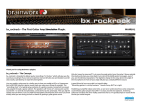
![User Manual - akmedia.[bleep]digidesign.](http://vs1.manualzilla.com/store/data/005947622_1-360bb364ea06dbb20bbae00c2eb5f9ad-150x150.png)

